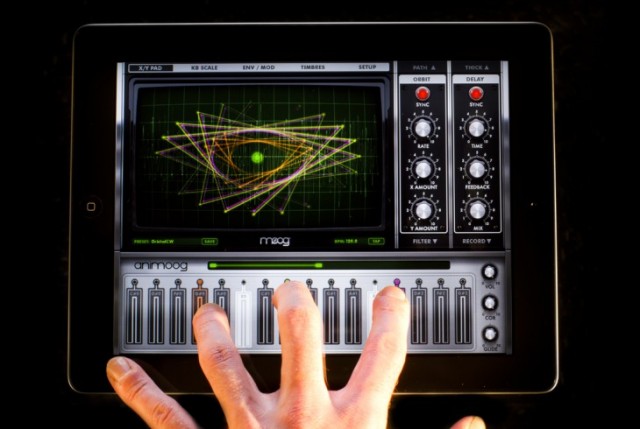Forget for a moment whether it says Moog or not. Maybe it could say “Rogue” or “Brogue” or “Kylie Minogue.” Animoog would still be one of the handful of software instruments that really make the iPad feel like a proper synth. And yes, it is also beautifully polyphonic, expressive, features an interface that could only work on iPad, and sounds amazing.
There’s been just one problem: amidst an avalanche of Apple OS updates, that synth wasn’t always working reliably. And the love from the developer (yes, the famous one that rhymes with “Vogue”) didn’t seem to match the love from its users, frankly.
That changes now. Apart from Retina graphics and Audiobus released previously, this week Animoog has gotten a long-awaited flurry of fixes and some new features, too.
If we had to sum it up in two words, it’d be these:
It’s stable.
And beyond that, just all around better. I’ll get to details, but first, let’s take a moment and watch the complete awesomeness of the touch screen being used to play South Indian Classical music:
Navneeth Sundar, a composer and pianist from Chennai, has recently discovered that the touch screen provided by the Apple iPad can be used to perform different kinds of music, including Carnatic music (South Indian Classical Music). The app used in this performance is “Animoog” created by “Moog Music Inc”. This particular patch, created by Navneeth himself on the app, is specific to a particular ragam or scale, which in this case is the ragam Desh and its parameters can be tweaked to suit other ragams, which makes it possible to explore the myriad dimensions and expressions there are, in Classical Carnatic music.
Pranaams to Shri. Lalgudi G. Jayaraman, the legend, whose Desh Thillana composition we’ve performed here.
Really beautiful stuff. I’d love to hear if there are other non-Western musical applications for synths, generally (more advertising that in a separate post, as it seems I have been charged in talking about the topic at this year’s SONAR Festival).
Want more beautiful stuff? Look no further than this wonderful improvised album of etudes made on just the synth – clearly in this case, limiting the music to one tool proved inspirational. You can get them for free and remix them yourself for free – all 47 tracks’ worth:
Montreal’s Satri explains his work:
In a world where there’s hundreds of excellent albums being made available daily, what excites me about what I propose with this second album is that you don’t need anything special other than the Animoog app to reproduce or play similar tracks. They’re single-track improvisations with no loops, no sequencer, no external effects, no complex or expensive music gear, everything is done live playing Animoog.
I invite you to learn more in the album’s announcement and to listen to the tracks themselves which are available for free. I hope you’re amongst those who might get inspired by this album and enjoy playing Animoog yourself.
But there’s just a massive amount of work done to this synth, making it not just one of the best soft synths around, but one of the most mature, too. It’s a synth that acts as seriously as you want, one that feels like an actual tool and not just an app. And yes, I’d rather pay thirty bucks for that once than 3 bucks a hundred times for stuff I won’t use. (Also – uh, check the arithmetic on that for another reason.)
Now in this week’s release, called, humbly, “2.2.4”:
• Stable support for iOS 8
• Stable support for 64-bit devices
• Revised timbres panel with categories (touch-hold timbre in category for preview)
• Fixes for timbres showing up with domain name prefixes
• Audiobus input slot compatibility fixes
• Virtual Animoog MIDI ports are now always available even if no port is explicitly selected
• Improved IAA instrument compatibility (IAA transport panel will be done for a future release)
• Use with any buffer size from 128 to 4096 (256 being the intended size for all supported devices)
• Fixes for restore purchase functionality
• Improved in-app store layout and interaction
• iTunes File Sharing access to timbres, presets and projects
• Removed import/export preset from setup panel since iTunes File Sharing should cover all needs
• Added timbre category list under ‘random preset’ to enable/disable categories to randomize timbres from
• 4-track recorder fixes for loading clips, pasting clips and AudioPaste
• 4-track project fixes for save/load/delete/share
• 4-track now remains unlocked when not connected to network
• Pitch bend range is now always saved with presets and correctly loads from presets when this option is active
• Pitch and mod strips now light up with incoming MIDI
• Hold button now more clearly shows when it’s active
• Manual MIDI CC input now ensures only numbers can be entered
• Keyboard scale selection now doesn’t misbehave after selecting the whole tone scale
• Preset panel is laid out more consistently
• Resuming after interruptions from Siri now reactivates audio
• Proper handling of large amounts of MIDI expression data, coming from alternative controllers
• Updated built-in manual
So, how did this change? There’s now a team in place to support the app properly, including friend-of-the-site Geert Bevin, who recently came onboard at Moog and shares this news (and artist tips) with CDM. Congrats on the great work, Geert; we look forward to more.
Animoog [Moog Apps]
